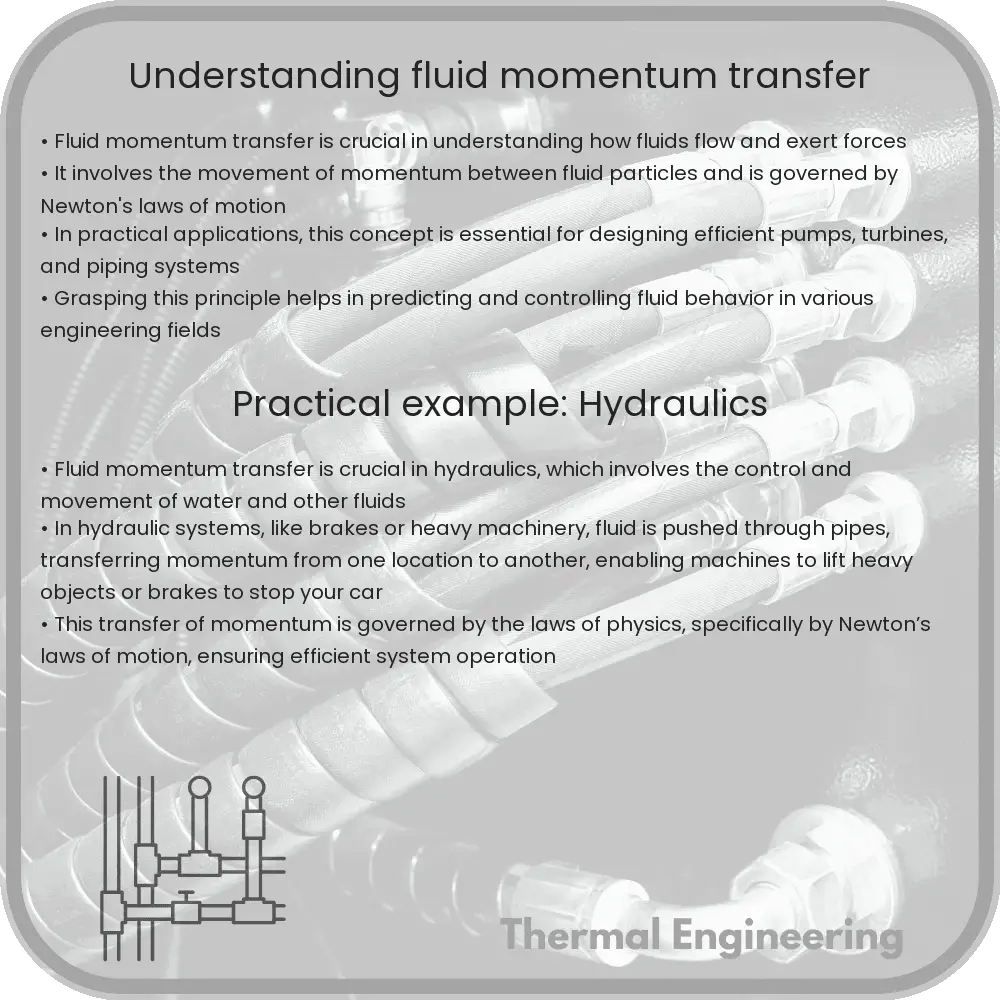Explore the concept of fluid momentum transfer, a key aspect of fluid dynamics critical for optimizing engineering systems like pipes and turbines.

Understanding Fluid Momentum Transfer
Fluid momentum transfer is a fundamental concept within the field of fluid dynamics, which is a branch of physics and engineering that deals with the behavior of fluids (liquids and gases). Understanding how momentum is transferred in fluids is essential for designing and optimizing various mechanical systems such as pipes, pumps, and turbines.
Basics of Fluid Momentum
Momentum, in the context of physics, refers to the quantity of motion of a moving body. For fluids, momentum is a product of the mass flow rate and the velocity of the fluid. It can be expressed as:
\[ P = m \cdot v \]
- m – mass of the fluid
- v – velocity of the fluid
Fluid momentum transfer involves the exchange or modification of this momentum due to forces acting on the fluid, such as pressure differences, gravitational forces, or interaction with solid surfaces.
Applications in Engineering
Engineers often need to analyze and control the momentum transfer in fluid systems to ensure efficient operation of devices and processes. Here are a few common applications:
- Piping Systems: The design of piping systems to minimize loss of pressure and energy due to friction and turbulence.
- Turbines: In turbines, the kinetic energy of fluids (often water or steam) is converted into mechanical energy. Understanding momentum transfer is critical in optimizing turbine efficiency and output.
- Jet Engines: In jet engines, air is accelerated to produce thrust. Efficient transfer of the air’s momentum to the engine thrust is key to performance.
Key Equations and Principles
The fundamental principles governing fluid momentum transfer include the conservation of momentum, Bernoulli’s equation, and Newton’s laws, which provide a framework to predict and analyze fluid behavior under various conditions.
One of the principal equations is the Momentum Equation which, in its conservation form, is stated as:
\[ \frac{\partial (\rho \cdot v)}{\partial t} + \nabla \cdot (\rho \cdot v \cdot v) = -\nabla p + f \]
- ρ – fluid density
- v – fluid velocity vector
- p – pressure
- f – external forces (e.g., gravity, friction)
Challenges in Fluid Momentum Transfer
One of the main challenges in fluid dynamics and momentum transfer is dealing with turbulent flow. Turbulence is a complex, irregular type of flow that can lead to increased resistance and energy loss in fluid-moving systems. Accurately predicting and mitigating turbulence effects is critical for efficient system design.
Additionally, the shift to sustainable and renewable energy sources poses both challenges and opportunities in fluid momentum transfer applications. Engineers must innovate to harness kinetic energies more effectively, particularly in water and wind turbines.
Conclusion
Understanding fluid momentum transfer is crucial for the optimization and innovation of many engineering systems. By manipulating the equations and principles discussed, engineers can design more efficient transportation systems, energy generation methods, and industrial processes, ultimately leading to advancements in technology and conservation of resources.